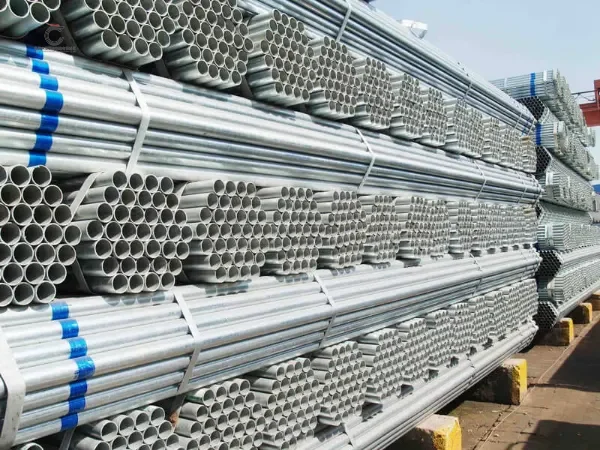Galvanization of hot-dip galvanized steel pipes
Zinc is a metallurgical reaction process. Microscopically, the process of hot-dip galvanizing is in two dynamic equilibria.
When a steel workpiece is immersed in molten zinc at about 450°C, the zinc at room temperature absorbs heat from the workpiece and reaches above 200°C. The interaction between zinc and iron becomes apparent and zinc and iron penetrate the surface. As the temperature of the workpiece gradually approaches that of molten zinc, zinc and iron alloy layers with different proportions are formed on the surface of the workpiece, forming a layered structure of zinc plating, and with the extension of time, the growth of different alloy plating layers presents different rates. From a macroscopic point of view, the above process is manifested by immersing the workpiece into the zinc solution, and the zinc and iron reactions are gradually balanced when the zinc solution occurs boiling, and the zinc surface is gradually calmed. After the workpiece is made into a zinc surface, the temperature of the workpiece is gradually reduced to below 200°C, the zinc and iron reactions are stopped, and the thickness of the hot dip galvanized layer is determined.

Thickness of zinc layer of hot-dip galvanized steel pipe
The main factors of zinc layer thickness are: base metal composition, surface roughness of the steel, content and distribution of active elements silicon and phosphorus in the steel, internal stress of the steel, geometry of the workpiece, hot dip galvanizing process, etc. The current international and Chinese standards are divided by steel thickness, and the thickness of the galvanized layer is comparable to the thickness that should be achieved locally to determine the anti-corrosion properties of the galvanized layer. Workpieces with different steel thicknesses have different times to reach thermal equilibrium and exchange equilibrium with zinc ions, resulting in different thicknesses of the coating. The standard for the average thickness of the coating is based on the mechanism of galvanization in industrial production, and the local thickness of the zinc layer is empirical considering the uneven distribution of the coating and the need for corrosion protection. Therefore, the requirements of the ISO, ASTM, JIS and Chinese standards for the thickness of the zinc layer differ slightly and are largely the same.
Zinc layer properties of hot-dip galvanized steel pipes
The thickness of the zinc layer determines the performance of the anticorrosive coating of the part. For the thin steel plate below 3 mm surface is smooth, it is difficult to get thicker coating in industrial production, in addition, it is not proportional to the thickness of the zinc layer of the steel plate, which will affect the adhesion strength of the coating to the substrate and the quality of the appearance of the coating. Too thick coating will cause rough appearance of the coating, easy to peel off, and the plated parts cannot withstand collision during handling and installation. If there are more active elements of silicon and phosphorus in the steel, it has been difficult to have a thinner coating in industrial production, which is the silicon content in the steel affects the way of growth between zinc and iron alloy layers.
Cangzhou Shenlong Pipe Industry is the world's leading supplier of carbon steel pipes, stainless steel pipes, seamless pipes, welded pipes, galvanized pipes, casing and steel fittings.






